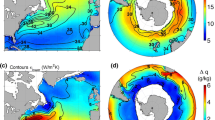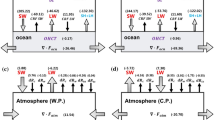Abstract
Vertical stratification changes at low frequency over the last decades are the largest in the western-central Pacific and have the potential to modify the balance between ENSO feedback processes. Here we show evidence of an increase in thermocline feedback in the western-central equatorial Pacific over the last 50 years, and in particular after the climate shift of 1976. It is demonstrated that the thermocline feedback becomes more effective due to the increased stratification in the vicinity of the mean thermocline. This leads to an increase in vertical advection variability twice as large as the increase resulting from the stronger ENSO amplitude (positive asymmetry) in the eastern Pacific that connects to the thermocline in the western-central Pacific through the basin-scale ‘tilt’ mode. Although the zonal advective feedback is dominant over the western-central equatorial Pacific, the more effective thermocline feedback allows for counteracting its warming (cooling) effect during warm (cold) events, leading to the reduced covariability between SST and thermocline depth anomalies in the NINO4 (160°E–150°W; 5°S–5°N) region after the 1976 climate shift. This counter-intuitive relationship between thermocline feedback strength as derived from the linear relationship between SST and thermocline fluctuations and stratification changes is also investigated in a long-term general circulation coupled model simulation. It is suggested that an increase in ENSO amplitude may lead to the decoupling between eastern and central equatorial Pacific sea surface temperature anomalies through its effect on stratification and thermocline feedback in the central-western Pacific.











Similar content being viewed by others
References
An S-I (2009) A review of interdecadal changes in the nonlinearity of the El Nino-southern oscillation. Theor Appl Climatol 97:29–40
An S-I, Jin F–F (2000) An eigen analysis of the interdecadal changes in the structure and frequency of ENSO mode. Geophys Res Lett 27:1573–1576
An S-I, Jin F–F (2001) Collective role of thermocline and zonal advective feedbacks in the ENSO mode. J Clim 14:3421–3432
An S-I, Wang B (2000) Interdecadal change of the structure of the ENSO mode and its impact on ENSO frequency. J Clim 13:2044–2055
An S-I, Kug J-S, Ham Y-G, Kang I-S (2008) Successive modulation of ENSO to the future greenhouse warming. J Clim 21:3–21
Ashok K, Behera SK, Rao SA, Weng H, Yamagata T (2007) El Niño Modoki and its possible teleconnection. J Geophys Res 112:C11007
Belmadani A, Dewitte B, An S-I (2010) ENSO feedbacks and associated time scales of variability in a multimodel ensemble. J Clim 23:3181–3204
Boyer TP, Conkright ME, Antonov JI, Baranova O, Garcia HE, Gelfeld R, Johnson D, Locarnini RA, Murphy PP, O’Brien TD, Smolyar I, Stephens C (2002) NOAA Atlas Nesdis 43 World Ocean Database, 2001. Volume 2: temporal distribution of bathythermograph profiles. U.S. Gov. Printing Office, Washington DC
Choi J, An S-I, Kug J-S, Yeh S-W (2011) The role of mean state on changes in El Nino’s flavor. Clim Dyn 37:1205–1215
Choi J, An S-I, Yeh S-W (2012) Decadal amplitude modulation of two types of ENSO and its relationship with the mean state. Clim Dyn 38:2631–2644
Clarke AJ (2010) Analytical theory for the quasi-steady and low-frequency equatorial ocean response to wind forcing: the “Tilt” and “Warm Water Volume” modes. J Phys Oceanogr 40(1):121–137
Collins M, An S-I, Cai W, Ganachaud A, Guilyardi E, Jin F–F, Jochum M, Lengaigne M, Power S, Timmermann A, Vecchi G, Wittenberg A (2010) The impact of global warming on the tropical Pacific Ocean and El Niño. Nat Geosci 3:391–397
Compo GP, Whitaker JS, Sardeshmukh PD (2006) Feasibility of a 100-year reanalysis using only surface pressure data. Bull Am Meteorol Soc 87:175–190. doi:10.1175/BAMS-87-2-175
Delworth TL et al (2006) GFDL’s CM2 global coupled climate models. Part I: Formulation and simulation characteristics. J Clim 19:634–674
Dewitte B (2000) Sensitivity of an intermediate coupled ocean-atmosphere model of the tropical Pacific to its oceanic vertical structure. J Clim 13:2363–2388
Dewitte B, Reverdin G, Maes C (1999) Vertical structure of an OGCM simulation of the equatorial Pacific Ocean in 1985–1994. J Phys Oceanogr 29:1542–1570
Dewitte B, Yeh S-W, Moon B-K, Cibot C, Terray L (2007) Rectification of the ENSO variability by interdecadal changes in the equatorial background mean state in a CGCM simulation. J Clim 20(10):2002–2021
Dewitte B, Thual S, Yeh S-W, An S-I, Moon B-K, Giese B (2009) Low frequency variability of temperature in the vicinity of the equatorial thermocline in SODA: role of equatorial wave dynamics and ENSO asymmetry. J Clim 22:5783–5795
Dewitte B, Choi J, An S-I, Thual S (2012) Vertical structure variability and equatorial waves during central Pacific and eastern Pacific El Niños in a coupled general circulation model. Clim Dyn 1–15. doi:10.1007/s00382-011-1215-x
DiNezio P, Clement A, Vecchi G, Soden B, Kirtman B, Lee S-K (2009) Climate response of the equatorial Pacific to global warming. J Clim 22(18):4873–4892. doi:10.1175/2009JCLI2982.1
Fedorov AV, Philander SG (2001) A stability analysis of Tropical Ocean–Atmosphere interactions: bridging measurements and theory for El Niño. J Clim 14(14):3086–3101
Giese B, Ray S (2011) El Niño variability in simple ocean data assimilation (SODA):1871–2008. J Geophys Res 116:C02024. doi:10.1029/2010JC006695
Gill AE (1982) Atmosphere-ocean dynamics. Academic Press, New York
Gnanadesikan et al (2006) GFDL's CM2 global coupled climate models. Part II: The baseline ocean simulation. J Clim 19:675–697
Griffies SM et al (2005) Formulation of an ocean model for global climate simulations. Ocean Sci 1:45–79
Hirst AC (1986) Unstable and damped equatorial modes in simple coupled ocean-atmosphere models. J Atmos Sci 43(6):606–632
Jin F–F, Neelin JD (1993) Modes of interannual tropical ocean-atmosphere interaction—a unified view. Part I: numerical results. J Atmos Sci 50:3477–3503
Jin F–F, An S-I, Timmermann A, Zhao J (2003) Strong El Nino events and nonlinear dynamical heating. Geophys Res Lett 30:1120
Kao H-Y, Yu J-Y (2009) Contrasting Eastern-Pacific and Central-Pacific types of ENSO. J Clim 22:615–632
Kug J-S, Jin F–F, An S-I (2009) Two-types of El Niño events: Cold Tongue El Niño and Warm Pool El Niño. J Clim 22:1499–1515
Kug J-S, Choi J, An S-I, Jin F–F, Wittenberg A-T (2010) Warm Pool and Cold Tongue El Niño events as simulated by the GFDL2.1 coupled GCM. J Clim 23:1226–1239
Lee T, McPhaden M (2010) Increasing intensity of El Nino in the central-equatorial Pacific. Geophys Res Lett 37:L14603. doi:10.1029/2010GL044007
Lin S-J (2004) A "vertically Lagrangian" finite-volume dynamical core for global models. Mon Wea Rev 132:2293–2307
Locarnini RA, Conkright ME, Antonov JI, Baranova O, Boyer TP, Garcia HE, Gelfeld R, Johnson D, Murphy PP, O’Brien TD, Smolyar I, Stephens C (2002) NOAA Atlas Nesdis 45 World Ocean Database, 2001. Volume 4: Temporal distribution of temperature, salinity and oxygen profiles. U.S. Gov. Printing Office, Washington DC
McPhaden MJ, Busalacchi AJ, Cheney R, Donguy JR, Gage KS, Halpern D, Ji M, Julian P, Meyers G, Mitchum GT, Niiler PP, Picaut J, Reynolds RW, Smith N, Takeuchi K (1998) The Tropical Ocean-Global Atmosphere (TOGA) observing system: a decade of progress. J Geophys Res 103:14169–14240
Moon B-K, Yeh S-W, Dewitte B, Jhun J-G, Kang I-S, Kirtman BP (2004) Vertical structure variability in the equatorial Pacific before and after the Pacific climate shift of the 1970 s. Geophys Res Lett 31:L03203. doi:10.1029/2003GL018829
Neelin JD, Battisti DS, Hirst AC, Jin F–F, Wakata Y, Yamagata T, Zebiak SE (1998) ENSO theory. J Geophys Res Oceans 103:14261–14290
Picaut J, Masia F, du Penhoat Y (1997) An advective-reflective conceptual model for the oscillatory nature of the ENSO. Science 277(5326):663–666
Rasmusson EM, Carpenter TH (1982) Variations in tropical sea surface temperature and surface wind fields associated with the Southern Oscillation/El Nin˜o. Month Weather Rev 110:354–384
Rayner NA, Parker DE, Horton EB, Folland CK, Alexander LV, Rowell DP, Kent EC, Kaplan A (2003) Global analyses of sea surface temperature, sea ice, and night marine air temperature since the late nineteenth century. J Geophys Res 108(D14):4407. doi:10.1029/2002JD002670
Stephens C, Conkright ME, Antonov JI, Baranova O, Boyer TP, Garcia HE, Gelfeld R, Johnson D, Locarnini RA, Murphy PP, O’Brien TD, Smolyar I (2002) NOAA Atlas Nesdis 44 World Ocean Database, 2001. Volume 3: temporal distribution of conductivity/salinity-temperature-depth (pressure) casts. U.S. Gov. Printing Office, Washington DC
Smith RD, Dukowicz JK, Malone RC (1992) Parallel ocean general circulation modelling. Physica D 60:38–61
Takahashi K, Montecinos A, Goubanova K, Dewitte B (2011) ENSO regimes: reinterpreting the canonical and Modoki El Niño. Geophys Res Lett 38:L10704. doi:10.1029/2011GL047364
Thual S, Dewitte B, An S-I, Ayoub N (2011) Sensitivity of ENSO to stratification in a recharge–discharge conceptual model. J Clim 24(16):4332–4349
Timmermann A, Jin F–F, Abshagen J (2003) A nonlinear theory for El Niño bursting. J Atmos Sci 60(1):152–165
Whitaker JS, Compo GP, Wei X, Hamill TM (2004) Reanalysis without radiosondes using ensemble data assimilation. Month Weather Rev 132:1190–1200
Wittenberg A, Rosati TA, Lau N-C, Ploshay JJ (2006) GFDL’s CM2 global coupled climate models. Part III: Tropical Pacific climate and ENSO. J Clim 19:698–722
Wyrtki K (1982) The southern oscillation, ocean-atmosphere interaction and El Niño. Mar Tech Soc J 6(1):3–10
Yeh S-W, Kug S-J, Dewitte B, Kwon M-H, Kirtman BP, Jin F–F (2009) El Niño in a changing climate. Nature 461:511–514
Yeh S-W, Dewitte B, Yim BY, Noh Y (2010) Role of the upper ocean structure in the response of ENSO-like SST variability to global warming. Clim Dyn. doi:10.1007/s00382-010-0849-4
Zebiak SE, Cane MA (1987) A model of El Niño-southern oscillation. Mon Wea Rev 115:2262–2278
Zelle H, Appeldoorn G, Burgers G, van Oldenborgh GJ (2004) The Relationship between sea surface temperature and thermocline depth in the eastern Equatorial Pacific. J Phys Oceanogr 34(3):643–655
Acknowledgments
We are grateful to Pr. Soon-Il An (Univ. of Yonseï) for fruitful discussions. The anonymous reviewer is also thanked for his constructive comments that helped to improve the manuscript. This work was supported by the STAR (Science and Technology Amicable Research) program and the Korean Government (National Research Foundation of Korea-2011-K1A2A012-2012-0005885). S.-W. Yeh was also funded by the Korea Meteorological Administration Research and Development Program under grant CATER 2012–3041.
Author information
Authors and Affiliations
Corresponding author
Rights and permissions
About this article
Cite this article
Dewitte, B., Yeh, SW. & Thual, S. Reinterpreting the thermocline feedback in the western-central equatorial Pacific and its relationship with the ENSO modulation. Clim Dyn 41, 819–830 (2013). https://doi.org/10.1007/s00382-012-1504-z
Received:
Accepted:
Published:
Issue Date:
DOI: https://doi.org/10.1007/s00382-012-1504-z




